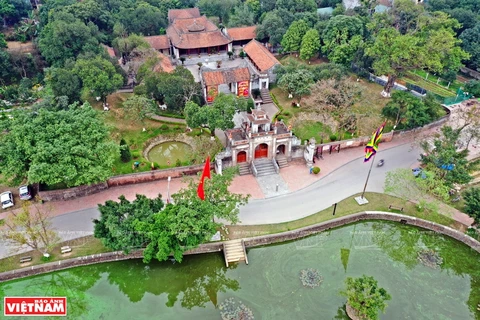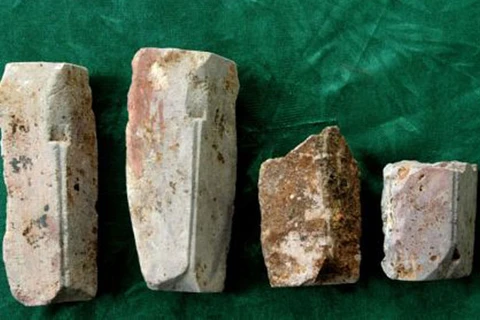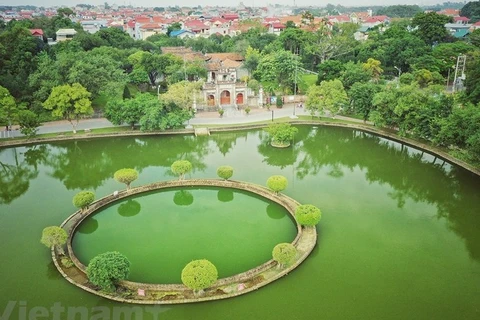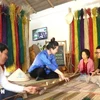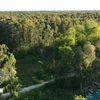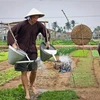 Renowned as a cultural relic and evidence of ancient Vietnamese’ creativeness and craftsmanship, Co Loa Ancient Citadel remains an ideal destination for visitors. Co Loa, the largest and oldest ancient citadel found in Vietnam, was built under the reign of King An Duong Vuong around the third century BC as the capital of then Au Lac Kingdom (now Vietnam). Its name "Co Loa" is derived from the Sino-Vietnamese for "old spiral" as the structure is built in a spiral shape. Covering a ground of 500 hectares, the citadel is located on a beautiful countryside in Hanoi’s outlying district of Dong Anh. (Photo: VietnamPlus)
Renowned as a cultural relic and evidence of ancient Vietnamese’ creativeness and craftsmanship, Co Loa Ancient Citadel remains an ideal destination for visitors. Co Loa, the largest and oldest ancient citadel found in Vietnam, was built under the reign of King An Duong Vuong around the third century BC as the capital of then Au Lac Kingdom (now Vietnam). Its name "Co Loa" is derived from the Sino-Vietnamese for "old spiral" as the structure is built in a spiral shape. Covering a ground of 500 hectares, the citadel is located on a beautiful countryside in Hanoi’s outlying district of Dong Anh. (Photo: VietnamPlus)  Co Loa Citadel was built near Phong Khe, about 20 km to the north of today’s Hanoi. Covering nearly 500 hectares, the citadel is a place of worship for King An Duong Vuong and Princess My Chau, who are mentioned in the magic crossbow legend that has been woven into the history of Vietnamese people. "The citadel shows ancient Vietnamese people's unique innovation during the long process of protecting the country from foreign invaders," according to researcher Trinh Hoang Hiep from the Vietnam Archaeology Institute. "Before Co Loa was built, there was no other construction site in such a large area in the Hong (Red) River Delta," Hiep said. "In order to build Co Loa, a strong army might have been mobilised." (Photo: VietnamPlus)
Co Loa Citadel was built near Phong Khe, about 20 km to the north of today’s Hanoi. Covering nearly 500 hectares, the citadel is a place of worship for King An Duong Vuong and Princess My Chau, who are mentioned in the magic crossbow legend that has been woven into the history of Vietnamese people. "The citadel shows ancient Vietnamese people's unique innovation during the long process of protecting the country from foreign invaders," according to researcher Trinh Hoang Hiep from the Vietnam Archaeology Institute. "Before Co Loa was built, there was no other construction site in such a large area in the Hong (Red) River Delta," Hiep said. "In order to build Co Loa, a strong army might have been mobilised." (Photo: VietnamPlus)  According to folklore, Thuc Phan (King An Duong Vuong) defeated the last of the Hung kings in 257 BC and founded the kingdom of Au Lac, choosing the site of Co Loa as his capital. Co Loa is a very large site and is the dominant presence in the northern flood plain of the Red River Delta, so building it would have required a large amount of labour and resources. The story goes that when the citadel was built, all work done during the day was destroyed at night. The king made a sacrifice and that night Than Kim Quy (Gold Turtle God) came to him in a dream and told him that he was building the citadel on the turtle's carapace. The turtle god instructed him to build the citadel in a new location, that of present-day Co Loa. The king did so, and the citadel was soon finished. (Photo: VietnamPlus)
According to folklore, Thuc Phan (King An Duong Vuong) defeated the last of the Hung kings in 257 BC and founded the kingdom of Au Lac, choosing the site of Co Loa as his capital. Co Loa is a very large site and is the dominant presence in the northern flood plain of the Red River Delta, so building it would have required a large amount of labour and resources. The story goes that when the citadel was built, all work done during the day was destroyed at night. The king made a sacrifice and that night Than Kim Quy (Gold Turtle God) came to him in a dream and told him that he was building the citadel on the turtle's carapace. The turtle god instructed him to build the citadel in a new location, that of present-day Co Loa. The king did so, and the citadel was soon finished. (Photo: VietnamPlus)  Co Loa Citadel covers the three communes of Co Loa, Viet Hung and Duc Tu in Dong Anh district. It was in the shape of a conch shell and had nine walls, each protected by a moat. The moats were part of a series of streams and lakes that exist to this day and provided Co Loa with protection and navigation. Out of gratefulness to the king, the magic turtle gave the king a toenail of itself that he could use as a trigger on his crossbow. When used, it multiplied its force by thousands of times and can kill thousands of enemies in one time. An Duong Vuong was fond of the crossbow very much, always hanging next to the place he lay. (Photo: VietnamPlus)
Co Loa Citadel covers the three communes of Co Loa, Viet Hung and Duc Tu in Dong Anh district. It was in the shape of a conch shell and had nine walls, each protected by a moat. The moats were part of a series of streams and lakes that exist to this day and provided Co Loa with protection and navigation. Out of gratefulness to the king, the magic turtle gave the king a toenail of itself that he could use as a trigger on his crossbow. When used, it multiplied its force by thousands of times and can kill thousands of enemies in one time. An Duong Vuong was fond of the crossbow very much, always hanging next to the place he lay. (Photo: VietnamPlus)  Sitting on a mound shaped like a dragon's head, An Duong Vuong Temple is surrounded by two forests on both sides, below there are two round holes called dragon eyes. According to legend, one of the Qin dynasty leaders, Zhao Tuo, took advantage of the decline of the Qin and created his own kingdom north of Au Lac. He tried to conquer his southern neighbour but was repeatedly defeated, so he had to wait for the opportunity. He later sent his son, Prince Trong Thuy, to negotiate a peace treaty and ask for the hand of Princess My Chau, An Duong Vuong’s daughter, in marriage. My Chau carelessly told her new husband about the crossbow, who then stole it and replaced it with a fake one, leading to a devastating defeat against Au Lac. (Photo: VietnamPlus)
Sitting on a mound shaped like a dragon's head, An Duong Vuong Temple is surrounded by two forests on both sides, below there are two round holes called dragon eyes. According to legend, one of the Qin dynasty leaders, Zhao Tuo, took advantage of the decline of the Qin and created his own kingdom north of Au Lac. He tried to conquer his southern neighbour but was repeatedly defeated, so he had to wait for the opportunity. He later sent his son, Prince Trong Thuy, to negotiate a peace treaty and ask for the hand of Princess My Chau, An Duong Vuong’s daughter, in marriage. My Chau carelessly told her new husband about the crossbow, who then stole it and replaced it with a fake one, leading to a devastating defeat against Au Lac. (Photo: VietnamPlus)  The large lake in front of the temple. Inside the lake is Trong Thuy Well, also known as Ngoc Well, where, according to legend, Trong Thuy committed suicide. Fleeing his enemies, King An Duong spotted his daughter leaving a trail of goose feathers for Trong Thuy to follow. The King came to his sense, pulling out his sword and beheading My Chau. Stories of the Thuc king's demise vary. Some say he committed suicide by jumping in the ocean. Some say he was borne off to sea by the magic turtle and never seen again. Some say he was told of his daughter's betrayal by the magic turtle and killed her before disappearing with the turtle. Trong Thuy, for his part, found My Chau shortly after and, overwhelmed with grief, drowned himself in a well in Co Loa Citadel. (Photo: VietnamPlus)
The large lake in front of the temple. Inside the lake is Trong Thuy Well, also known as Ngoc Well, where, according to legend, Trong Thuy committed suicide. Fleeing his enemies, King An Duong spotted his daughter leaving a trail of goose feathers for Trong Thuy to follow. The King came to his sense, pulling out his sword and beheading My Chau. Stories of the Thuc king's demise vary. Some say he committed suicide by jumping in the ocean. Some say he was borne off to sea by the magic turtle and never seen again. Some say he was told of his daughter's betrayal by the magic turtle and killed her before disappearing with the turtle. Trong Thuy, for his part, found My Chau shortly after and, overwhelmed with grief, drowned himself in a well in Co Loa Citadel. (Photo: VietnamPlus)  The citadel was built in spiral shape that is reason why it is called Co Loa, which is derived from the Sino-Vietnamese for "old spiral". It was said that there were nine rings, deep water trench surrounded in outside circle. Nowadays, Co Loa Citadel remains three land rings: outside citadel (perimeter of 8km), the middle citadel (polygon, perimeter 6.5 km) and inside citadel (rectangular perimeter of 1.6 km). The citadel wall today has average height of 4-5 meters, some reach to 12 meters high; the citadel’s foundation is 20- 30 meters wide. Archaeologists found here thousands of bronze arrows, plows, axes, animal bones, etc. (Photo: VietnamPlus)
The citadel was built in spiral shape that is reason why it is called Co Loa, which is derived from the Sino-Vietnamese for "old spiral". It was said that there were nine rings, deep water trench surrounded in outside circle. Nowadays, Co Loa Citadel remains three land rings: outside citadel (perimeter of 8km), the middle citadel (polygon, perimeter 6.5 km) and inside citadel (rectangular perimeter of 1.6 km). The citadel wall today has average height of 4-5 meters, some reach to 12 meters high; the citadel’s foundation is 20- 30 meters wide. Archaeologists found here thousands of bronze arrows, plows, axes, animal bones, etc. (Photo: VietnamPlus)  Co Loa stretches across the three communes of Dong Anh, namely Co Loa, Viet Hung and Duc Tu. It covers a very large site and is the dominant presence in the northern flood plain of the Red River Delta, so building it would have required a large amount of labour and resources. Various relics of the Bronze Age Dong Son culture can be found at the site. With its unique historical, architectural and archeological value, the citadel has been recognised as a national relic since 1962 and as special national relic since 2012. It is also named among 21 national tourist sites. (Photo: VietnamPlus)
Co Loa stretches across the three communes of Dong Anh, namely Co Loa, Viet Hung and Duc Tu. It covers a very large site and is the dominant presence in the northern flood plain of the Red River Delta, so building it would have required a large amount of labour and resources. Various relics of the Bronze Age Dong Son culture can be found at the site. With its unique historical, architectural and archeological value, the citadel has been recognised as a national relic since 1962 and as special national relic since 2012. It is also named among 21 national tourist sites. (Photo: VietnamPlus)  The citadel takes various names like Loa Thanh, Con Lon Thanh, Tu Long Thanh, Cuu Thanh, Viet Vuong Thanh, Kha Lu Thanh and Co Loa Thanh. In the 10th century, it became the capital for the second time when Ngo Quyen was the king of the country. The citadel was built in spiral shape that is reason why it is called Loa Thanh. It was said that there were 9 rings, deep water trench surrounded in outside circle. Nowadays, Co Loa citadel remains 3 land rings: outside citadel (perimeter of 8km), the middle citadel (polygon, perimeter 6.5 km) and inside citadel (rectangular perimeter of 1.6 km). (Photo: VietnamPlus)
The citadel takes various names like Loa Thanh, Con Lon Thanh, Tu Long Thanh, Cuu Thanh, Viet Vuong Thanh, Kha Lu Thanh and Co Loa Thanh. In the 10th century, it became the capital for the second time when Ngo Quyen was the king of the country. The citadel was built in spiral shape that is reason why it is called Loa Thanh. It was said that there were 9 rings, deep water trench surrounded in outside circle. Nowadays, Co Loa citadel remains 3 land rings: outside citadel (perimeter of 8km), the middle citadel (polygon, perimeter 6.5 km) and inside citadel (rectangular perimeter of 1.6 km). (Photo: VietnamPlus)  Cao Lo Temple, one of many historical relics inside Co Loa Citadel Complex, is dedicated to Cao Lo, an excellent general under the dynasty of King An Duong Vuong who invented a multiple-shot crossbow. A statue of Cao Lo with crossbows was erected in the middle of the lake in front of the temple. There are also Co Loa Communal House, an upper shrine dedicated to King An Duong Vuong, and another to Princess My Chau. An Duong Vuong Temple is the most attractive place to visitors. Located on an old hill that once situated the king’s palace, the temple was built in 1687 under the dynasty of King Le Hi Tong and restored in 1893. (Photo: VietnamPlus)
Cao Lo Temple, one of many historical relics inside Co Loa Citadel Complex, is dedicated to Cao Lo, an excellent general under the dynasty of King An Duong Vuong who invented a multiple-shot crossbow. A statue of Cao Lo with crossbows was erected in the middle of the lake in front of the temple. There are also Co Loa Communal House, an upper shrine dedicated to King An Duong Vuong, and another to Princess My Chau. An Duong Vuong Temple is the most attractive place to visitors. Located on an old hill that once situated the king’s palace, the temple was built in 1687 under the dynasty of King Le Hi Tong and restored in 1893. (Photo: VietnamPlus)  An ancient well inside Co Loa Citadel. Built from the early days of the Vietnamese people, the citadel "witnessed" the Vietnamese people's glorious historical journey, and preserved the country's unique and valuable cultural values since ancient times. In addition, Co Loa Citadel is also an evidence showing the creativity and technical skills of the Vietnamese from ancient times. Co Loa Citadel is an ideal tourist destination for visitors to learn about thousands of years of Vietnamese culture, as well as the outstanding architecture of Vietnam. In addition, visitors also have chances to get knowledge of Vietnam's history from its primitive times as well as famous Vietnamese legends. (Photo: VietnamPlus)
An ancient well inside Co Loa Citadel. Built from the early days of the Vietnamese people, the citadel "witnessed" the Vietnamese people's glorious historical journey, and preserved the country's unique and valuable cultural values since ancient times. In addition, Co Loa Citadel is also an evidence showing the creativity and technical skills of the Vietnamese from ancient times. Co Loa Citadel is an ideal tourist destination for visitors to learn about thousands of years of Vietnamese culture, as well as the outstanding architecture of Vietnam. In addition, visitors also have chances to get knowledge of Vietnam's history from its primitive times as well as famous Vietnamese legends. (Photo: VietnamPlus)  The ancient vestiges have now been fading by the stormy development of urban areas around the ancient citadel. Lying on the outskirts of Hanoi, Co Loa Citadel is one of attractive tourist destinations for visitors who wish to learn about Vietnamese culture and history. About 15 kilometers from the Hanoi Old Quarter, you can reach the citadel by motorbike or car according to the route: following Highway 1A, crossing the Duong River bridge, turning left from Yen Vien Town to enter Highway No.3, riding 5 km further to Co Loa Citadel. You can also move to Co Loa Citadel by bus to save travel costs. It is possible for visitors to catch Bus No.46 from My Dinh area, or Bus No.15 and 17 from Long Bien transit station. (Photo: VietnamPlus)
The ancient vestiges have now been fading by the stormy development of urban areas around the ancient citadel. Lying on the outskirts of Hanoi, Co Loa Citadel is one of attractive tourist destinations for visitors who wish to learn about Vietnamese culture and history. About 15 kilometers from the Hanoi Old Quarter, you can reach the citadel by motorbike or car according to the route: following Highway 1A, crossing the Duong River bridge, turning left from Yen Vien Town to enter Highway No.3, riding 5 km further to Co Loa Citadel. You can also move to Co Loa Citadel by bus to save travel costs. It is possible for visitors to catch Bus No.46 from My Dinh area, or Bus No.15 and 17 from Long Bien transit station. (Photo: VietnamPlus)  Co Loa Citadel is the oldest building in Vietnam associated with historic stories and legends. It was built in a spiral-shaped type. According to legend, the citadel had nine walls, however, after the discovery, archaeologists found only three main walls left. This place preserves a series of archaeological relics reflecting the continuous development of the Vietnamese people from at the beginnings through historic periods. Therefore, through the discovery of Co Loa Citadel, archaeologists discovered a unique and valuable Dong Son culture, also known as the Red River civilization of the Vietnamese people in the prehistoric time. The citadel has been recognised as a national relic since 1962 and as special national relic since 2012. (Photo: VietnamPlus)
Co Loa Citadel is the oldest building in Vietnam associated with historic stories and legends. It was built in a spiral-shaped type. According to legend, the citadel had nine walls, however, after the discovery, archaeologists found only three main walls left. This place preserves a series of archaeological relics reflecting the continuous development of the Vietnamese people from at the beginnings through historic periods. Therefore, through the discovery of Co Loa Citadel, archaeologists discovered a unique and valuable Dong Son culture, also known as the Red River civilization of the Vietnamese people in the prehistoric time. The citadel has been recognised as a national relic since 1962 and as special national relic since 2012. (Photo: VietnamPlus) VNA

